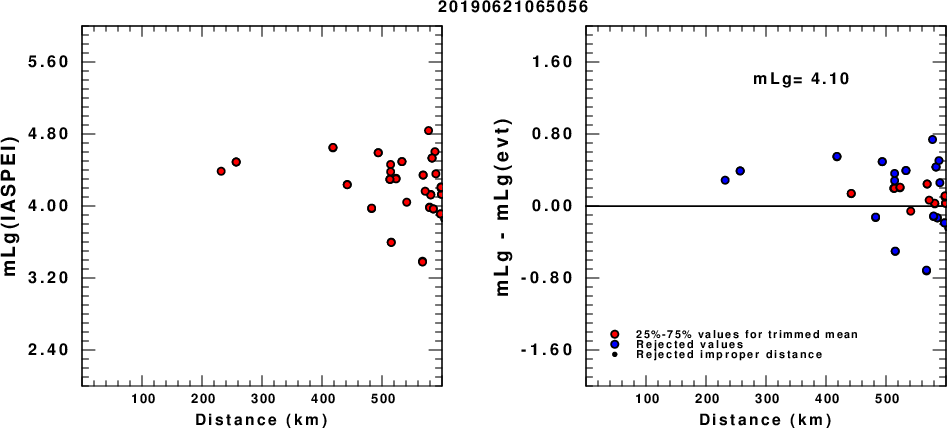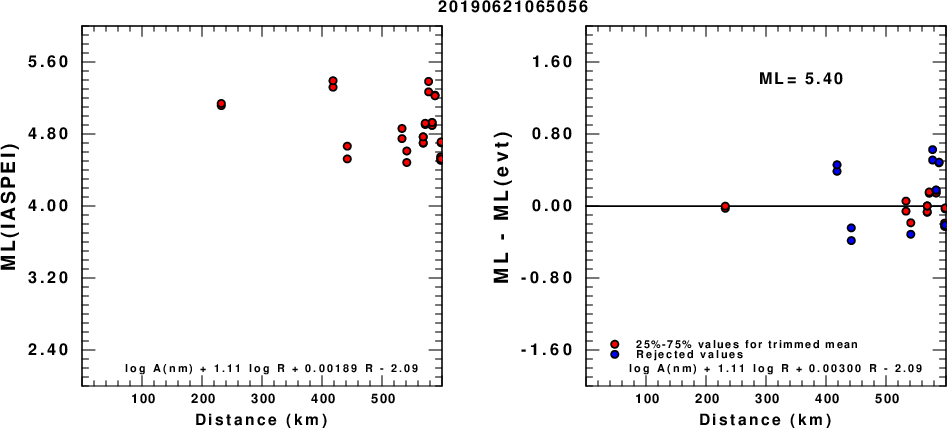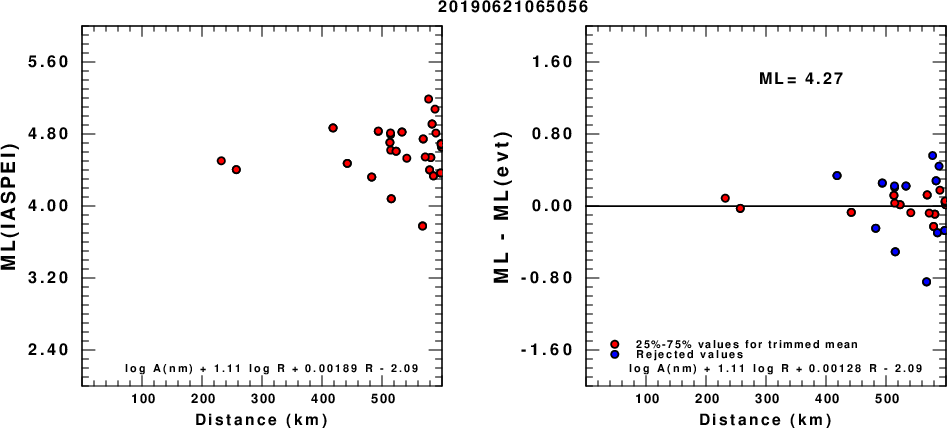
(a) mLg computed using the IASPEI formula; (b) mLg residuals ; the values used for the trimmed mean are indicated.
USGS/SLU Moment Tensor Solution
ENS 2019/06/21 06:50:56:1 47.15 -0.54 10.0 4.8 France
Stations used:
BE.MEM BE.UCC CH.BOURR CH.BRANT CH.DIX CH.EMING CH.FULLY
CH.GIMEL CH.HASLI CH.ILLEZ CH.MTI02 CH.SAIRA CH.SALAN
CH.SAVIG CH.SENIN CH.SULZ CH.TORNY G.CLF G.ECH GB.CCA1
GB.CWF GB.DYA GB.HMNX GB.HTL GB.WACR GE.WLF II.BFO II.XBFO
Filtering commands used:
cut o DIST/3.3 -30 o DIST/3.3 +50
rtr
taper w 0.1
hp c 0.02 n 3
lp c 0.06 n 3
Best Fitting Double Couple
Mo = 1.02e+22 dyne-cm
Mw = 3.94
Z = 12 km
Plane Strike Dip Rake
NP1 185 90 15
NP2 95 75 180
Principal Axes:
Axis Value Plunge Azimuth
T 1.02e+22 11 51
N 0.00e+00 75 185
P -1.02e+22 11 319
Moment Tensor: (dyne-cm)
Component Value
Mxx -1.72e+21
Mxy 9.73e+21
Mxz -2.31e+20
Myy 1.72e+21
Myz 2.64e+21
Mzz -2.32e+14
---------#####
-------------#########
------------#############
- P ------------############
--- ------------############ T #
-------------------############ ##
--------------------##################
---------------------###################
--------------------####################
---------------------#####################
##-------------------#####################
######---------------#####################
#############--------##################---
####################--------------------
###################---------------------
##################--------------------
#################-------------------
################------------------
##############----------------
#############---------------
#########-------------
#####---------
Global CMT Convention Moment Tensor:
R T P
-2.32e+14 -2.31e+20 -2.64e+21
-2.31e+20 -1.72e+21 -9.73e+21
-2.64e+21 -9.73e+21 1.72e+21
Details of the solution is found at
http://www.eas.slu.edu/eqc/eqc_mt/MECH.NA/20190621065056/index.html
|
STK = 185
DIP = 90
RAKE = 15
MW = 3.94
HS = 12.0
The NDK file is 20190621065056.ndk The waveform inversion is preferred.
The following compares this source inversion to others
USGS/SLU Moment Tensor Solution
ENS 2019/06/21 06:50:56:1 47.15 -0.54 10.0 4.8 France
Stations used:
BE.MEM BE.UCC CH.BOURR CH.BRANT CH.DIX CH.EMING CH.FULLY
CH.GIMEL CH.HASLI CH.ILLEZ CH.MTI02 CH.SAIRA CH.SALAN
CH.SAVIG CH.SENIN CH.SULZ CH.TORNY G.CLF G.ECH GB.CCA1
GB.CWF GB.DYA GB.HMNX GB.HTL GB.WACR GE.WLF II.BFO II.XBFO
Filtering commands used:
cut o DIST/3.3 -30 o DIST/3.3 +50
rtr
taper w 0.1
hp c 0.02 n 3
lp c 0.06 n 3
Best Fitting Double Couple
Mo = 1.02e+22 dyne-cm
Mw = 3.94
Z = 12 km
Plane Strike Dip Rake
NP1 185 90 15
NP2 95 75 180
Principal Axes:
Axis Value Plunge Azimuth
T 1.02e+22 11 51
N 0.00e+00 75 185
P -1.02e+22 11 319
Moment Tensor: (dyne-cm)
Component Value
Mxx -1.72e+21
Mxy 9.73e+21
Mxz -2.31e+20
Myy 1.72e+21
Myz 2.64e+21
Mzz -2.32e+14
---------#####
-------------#########
------------#############
- P ------------############
--- ------------############ T #
-------------------############ ##
--------------------##################
---------------------###################
--------------------####################
---------------------#####################
##-------------------#####################
######---------------#####################
#############--------##################---
####################--------------------
###################---------------------
##################--------------------
#################-------------------
################------------------
##############----------------
#############---------------
#########-------------
#####---------
Global CMT Convention Moment Tensor:
R T P
-2.32e+14 -2.31e+20 -2.64e+21
-2.31e+20 -1.72e+21 -9.73e+21
-2.64e+21 -9.73e+21 1.72e+21
Details of the solution is found at
http://www.eas.slu.edu/eqc/eqc_mt/MECH.NA/20190621065056/index.html
|

(a) mLg computed using the IASPEI formula; (b) mLg residuals ; the values used for the trimmed mean are indicated.

(a) ML computed using the IASPEI formula for Horizontal components; (b) ML residuals computed using a modified IASPEI formula that accounts for path specific attenuation; the values used for the trimmed mean are indicated. The ML relation used for each figure is given at the bottom of each plot.

(a) ML computed using the IASPEI formula for Vertical components (research); (b) ML residuals computed using a modified IASPEI formula that accounts for path specific attenuation; the values used for the trimmed mean are indicated. The ML relation used for each figure is given at the bottom of each plot.
 |
The focal mechanism was determined using broadband seismic waveforms. The location of the event and the and stations used for the waveform inversion are shown in the next figure.

|
|
|
The program wvfgrd96 was used with good traces observed at short distance to determine the focal mechanism, depth and seismic moment. This technique requires a high quality signal and well determined velocity model for the Green functions. To the extent that these are the quality data, this type of mechanism should be preferred over the radiation pattern technique which requires the separate step of defining the pressure and tension quadrants and the correct strike.
The observed and predicted traces are filtered using the following gsac commands:
cut o DIST/3.3 -30 o DIST/3.3 +50 rtr taper w 0.1 hp c 0.02 n 3 lp c 0.06 n 3The results of this grid search from 0.5 to 19 km depth are as follow:
DEPTH STK DIP RAKE MW FIT
WVFGRD96 1.0 5 65 10 3.69 0.4608
WVFGRD96 2.0 0 75 0 3.73 0.5405
WVFGRD96 3.0 0 80 -5 3.76 0.5847
WVFGRD96 4.0 5 80 10 3.81 0.6142
WVFGRD96 5.0 5 85 10 3.83 0.6354
WVFGRD96 6.0 5 85 10 3.85 0.6502
WVFGRD96 7.0 185 90 -5 3.87 0.6598
WVFGRD96 8.0 185 80 10 3.89 0.6715
WVFGRD96 9.0 185 80 10 3.91 0.6762
WVFGRD96 10.0 185 85 15 3.92 0.6790
WVFGRD96 11.0 185 85 15 3.93 0.6805
WVFGRD96 12.0 185 90 15 3.94 0.6808
WVFGRD96 13.0 5 90 -10 3.96 0.6798
WVFGRD96 14.0 185 85 10 3.96 0.6793
WVFGRD96 15.0 5 90 -10 3.97 0.6750
WVFGRD96 16.0 185 80 10 3.98 0.6740
WVFGRD96 17.0 185 80 10 3.99 0.6702
WVFGRD96 18.0 185 80 5 4.00 0.6656
WVFGRD96 19.0 185 80 5 4.01 0.6602
WVFGRD96 20.0 185 80 5 4.01 0.6537
WVFGRD96 21.0 185 80 5 4.02 0.6465
WVFGRD96 22.0 180 80 5 4.01 0.6390
WVFGRD96 23.0 180 80 5 4.02 0.6311
WVFGRD96 24.0 180 80 5 4.03 0.6224
WVFGRD96 25.0 180 80 5 4.04 0.6131
WVFGRD96 26.0 180 80 0 4.04 0.6035
WVFGRD96 27.0 180 80 0 4.05 0.5933
WVFGRD96 28.0 180 80 0 4.06 0.5827
WVFGRD96 29.0 180 80 0 4.07 0.5714
The best solution is
WVFGRD96 12.0 185 90 15 3.94 0.6808
The mechanism correspond to the best fit is

|
|
|
The best fit as a function of depth is given in the following figure:

|
|
|
The comparison of the observed and predicted waveforms is given in the next figure. The red traces are the observed and the blue are the predicted. Each observed-predicted component is plotted to the same scale and peak amplitudes are indicated by the numbers to the left of each trace. A pair of numbers is given in black at the right of each predicted traces. The upper number it the time shift required for maximum correlation between the observed and predicted traces. This time shift is required because the synthetics are not computed at exactly the same distance as the observed and because the velocity model used in the predictions may not be perfect. A positive time shift indicates that the prediction is too fast and should be delayed to match the observed trace (shift to the right in this figure). A negative value indicates that the prediction is too slow. The lower number gives the percentage of variance reduction to characterize the individual goodness of fit (100% indicates a perfect fit).
The bandpass filter used in the processing and for the display was
cut o DIST/3.3 -30 o DIST/3.3 +50 rtr taper w 0.1 hp c 0.02 n 3 lp c 0.06 n 3

|
|
|

|
| Focal mechanism sensitivity at the preferred depth. The red color indicates a very good fit to thewavefroms. Each solution is plotted as a vector at a given value of strike and dip with the angle of the vector representing the rake angle, measured, with respect to the upward vertical (N) in the figure. |
A check on the assumed source location is possible by looking at the time shifts between the observed and predicted traces. The time shifts for waveform matching arise for several reasons:
Time_shift = A + B cos Azimuth + C Sin Azimuth
The time shifts for this inversion lead to the next figure:

The derived shift in origin time and epicentral coordinates are given at the bottom of the figure.
Thanks also to the many seismic network operators whose dedication make this effort possible: University of Nevada Reno, University of Alaska, University of Washington, Oregon State University, University of Utah, Montana Bureas of Mines, UC Berkely, Caltech, UC San Diego, Saint Louis University, University of Memphis, Lamont Doherty Earth Observatory, the Iris stations and the Transportable Array of EarthScope.
The WUS.model used for the waveform synthetic seismograms and for the surface wave eigenfunctions and dispersion is as follows:
MODEL.01
Model after 8 iterations
ISOTROPIC
KGS
FLAT EARTH
1-D
CONSTANT VELOCITY
LINE08
LINE09
LINE10
LINE11
H(KM) VP(KM/S) VS(KM/S) RHO(GM/CC) QP QS ETAP ETAS FREFP FREFS
1.9000 3.4065 2.0089 2.2150 0.302E-02 0.679E-02 0.00 0.00 1.00 1.00
6.1000 5.5445 3.2953 2.6089 0.349E-02 0.784E-02 0.00 0.00 1.00 1.00
13.0000 6.2708 3.7396 2.7812 0.212E-02 0.476E-02 0.00 0.00 1.00 1.00
19.0000 6.4075 3.7680 2.8223 0.111E-02 0.249E-02 0.00 0.00 1.00 1.00
0.0000 7.9000 4.6200 3.2760 0.164E-10 0.370E-10 0.00 0.00 1.00 1.00
Here we tabulate the reasons for not using certain digital data sets
The following stations did not have a valid response files: